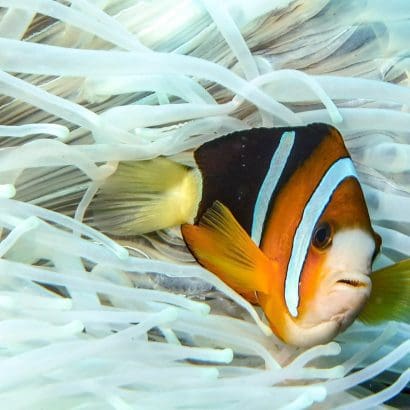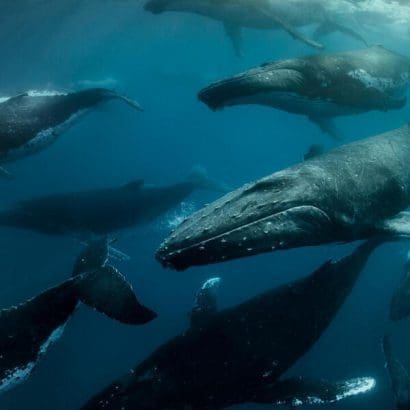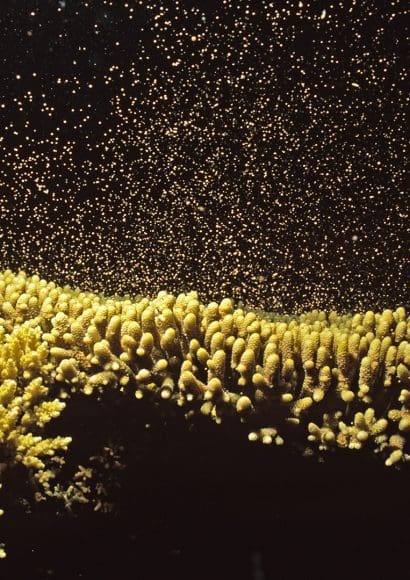
Coral spawning is a fascinating and pivotal event in the life cycle of corals. It is during this time that these remarkable organisms release their gametes into the water, contributing to the reproduction and growth of coral reefs. Understanding when and where coral spawning occurs is crucial for scientists, conservationists, and enthusiasts alike, as it provides insights into the complex reproductive strategies and ecological dynamics of coral ecosystems.
The timing and location of coral spawning are influenced by a variety of factors, including environmental conditions and biological cues. Temperature, light intensity, and lunar cycles play crucial roles in synchronizing the mass release of gametes by different coral species. Additionally, the specific habitats where coral reefs thrive, such as barrier reefs, fringing reefs, and atolls, serve as the backdrop for these awe-inspiring events.
In this article, we will delve into the fascinating world of coral spawning, exploring the intricacies of when and where this phenomenon takes place. We will examine the environmental factors that influence coral spawning, the geographical regions renowned for their coral spawning events, and the importance of these events for the survival and conservation of coral reefs.
Contents
What is coral spawning?.
Coral spawning refers to the reproductive process in which corals release their eggs and sperm, known as gametes, into the water. It is a remarkable natural event that occurs annually or periodically, depending on the species and environmental conditions. Coral spawning plays a vital role in the survival and growth of coral reefs, as it allows for the creation of new coral colonies and promotes genetic diversity within the population.
Corals have a unique reproductive strategy that involves both sexual and asexual methods. While asexual reproduction, such as budding and fragmentation, contributes to the expansion of existing coral colonies, sexual reproduction through spawning is crucial for the long-term sustainability and resilience of coral reef ecosystems.
Most coral species are hermaphroditic, meaning they possess both male and female reproductive organs within the same individual. However, some corals are gonochoric, with separate male and female colonies. The timing of coral spawning is often synchronized among individuals of the same species within a specific geographic region, and this mass release of gametes enhances the chances of successful fertilization.
Factors influencing coral spawning.
Coral spawning is influenced by several factors that play a crucial role in determining the timing and success of this reproductive event. Understanding these factors is essential for studying and predicting coral spawning patterns. Here are some general factors that influence coral spawning: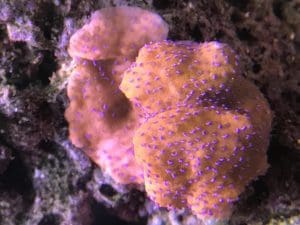
Water Temperature:
Temperature is one of the primary triggers for coral spawning. Most coral species have specific temperature thresholds at which they initiate spawning. Warmer water temperatures, usually occurring during the spring or summer months, are generally favorable for coral reproduction. Slight changes in temperature can affect the timing and synchronization of spawning among coral colonies.
Light and Lunar Cycles:
Light intensity and lunar cycles have a significant influence on coral spawning. Corals are known to have photoperiodic responses, meaning they can sense changes in light duration and intensity. The phases of the moon, particularly the full moon, are often associated with increased coral spawning activity. Moonlight serves as a cue for corals to release their gametes simultaneously, improving the chances of successful fertilization.
Environmental Cues:
Besides temperature and light, other environmental factors can influence coral spawning. Water quality, including nutrient levels, salinity, and dissolved oxygen, can affect the health and reproductive capacity of corals. Additionally, changes in weather patterns, such as storm events or significant fluctuations in water conditions, can impact the timing and extent of coral spawning.
Genetic Factors:
Genetic differences among coral colonies can influence their reproductive behaviors. Certain genetic variations may result in corals spawning at different times or having different responses to environmental cues. Genetic diversity within a coral population is essential for maintaining healthy and resilient reefs.
Symbiotic Relationships:
Corals have a symbiotic relationship with photosynthetic algae called zooxanthellae. The health and productivity of these algae can influence coral reproduction. When corals are stressed or experience environmental disturbances, they may expel their symbiotic algae, leading to decreased reproductive capacity.
Geographic Location:
Coral spawning can vary based on the geographic location of coral reefs. Different regions and even specific sites within a region may have unique spawning timings and species compositions. Factors such as local water currents, temperature gradients, and oceanographic conditions can contribute to the diversity and timing of coral spawning events.
Where does coral spawning occur?.
Coral spawning can occur in various locations, primarily in areas that support healthy and thriving coral reef ecosystems. Understanding where coral spawning occurs is essential for researchers, divers, and conservationists who wish to witness and study these remarkable events. Here is some general information about where coral spawning occurs:
Coral Reef Habitats:
Coral reefs serve as the primary locations for coral spawning. These diverse underwater ecosystems, characterized by an abundance of corals, provide the ideal habitat for coral colonies to thrive. Coral reefs can be found in tropical and subtropical regions around the world, typically in shallow, clear, and warm waters. They include various types such as barrier reefs, fringing reefs, and atolls.
Geographical Regions:
Coral spawning occurs in different geographic regions globally. Some renowned areas for coral spawning include the Great Barrier Reef in Australia, the Indo-Pacific region, the Caribbean Sea, the Red Sea, and the Coral Triangle (encompassing Indonesia, the Philippines, Malaysia, Papua New Guinea, Solomon Islands, and Timor-Leste). These regions are known for their rich coral biodiversity and host a multitude of coral species that partake in spawning events.
Specific Spawning Sites:
Within coral reef habitats, certain sites may exhibit higher levels of coral spawning activity. These sites, often referred to as “spawning aggregations,” are locations where multiple coral colonies release their gametes simultaneously. Spawning aggregations can occur on specific patches of reef or particular sections of a larger coral reef system. These sites are of particular interest to researchers and divers who aim to witness and document large-scale coral spawning events.
Microhabitats:
Within coral reef ecosystems, certain microhabitats may be more conducive to coral spawning. For example, crevices, nooks, or branching structures within the reef can provide shelter and protection for developing coral embryos and larvae. These microhabitats offer a higher chance of successful settlement and growth for the released gametes.
Coral spawning seasons.
Coral spawning seasons refer to specific periods during which coral colonies release their gametes in synchronized mass spawning events. These seasons vary depending on the geographic location, species of coral, and environmental conditions. Understanding coral spawning seasons is crucial for researchers, conservationists, and divers interested in witnessing or studying these awe-inspiring natural phenomena. Here is some general information about coral spawning seasons: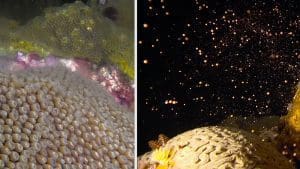
Timing:
Coral spawning seasons are often influenced by environmental cues, particularly water temperature and lunar cycles. In general, spawning events tend to occur during specific months or seasons. For example, in tropical regions, coral spawning often takes place during spring or summer when water temperatures are warmer. However, it’s important to note that the exact timing can vary between species and locations.
Synchronization:
One of the remarkable aspects of coral spawning is the synchronization among individuals of the same species within a given area. This synchronization enhances the chances of successful fertilization and increases genetic diversity. When environmental conditions are optimal, numerous coral colonies release their gametes simultaneously, creating a spectacular display of reproductive activity.
Species-Specific Spawning:
Different coral species may have distinct spawning seasons. Some species may spawn multiple times a year, while others may have more limited or specific spawning periods. Additionally, the duration of the spawning season can vary. Some species may have short and intense spawning events lasting only a few nights, while others may have more prolonged spawning periods spanning several weeks.
Geographic Variation:
Coral spawning seasons can also exhibit geographic variation. The timing of spawning events may differ between regions and even within specific coral reef areas. Factors such as local water conditions, temperature gradients, and oceanographic patterns can contribute to this variation. It’s important to consider the specific characteristics of the coral reef ecosystem under study to understand the timing and duration of coral spawning seasons in that particular location.
Research and Monitoring:
Researchers often conduct studies and monitoring programs to track and document coral spawning seasons. These efforts involve collecting data on the timing, frequency, and species involved in spawning events. By studying coral spawning patterns, scientists can gain insights into the reproductive success of different coral species, track changes in spawning behavior over time, and assess the overall health and resilience of coral reef ecosystems.
Ecotourism and Conservation:
Coral spawning seasons also attract the attention of divers and ecotourists who are interested in experiencing and witnessing these remarkable events. Responsible diving practices and guidelines are essential to minimize disturbances and protect the delicate coral colonies during their critical reproductive periods. Ecotourism activities can raise awareness about the importance of coral reef conservation and support local initiatives aimed at preserving these fragile ecosystems.
Importance and conservation of coral spawning.
In conclusion, the process of coral spawning holds immense importance for the survival and vitality of coral reef ecosystems. Understanding and conserving coral spawning events is crucial for several reasons.
Firstly, coral spawning plays a fundamental role in the reproduction and growth of coral reefs. By releasing their gametes into the water, corals ensure the continuation of their species and the formation of new colonies. The genetic diversity generated through successful fertilization during spawning events enhances the resilience and adaptability of coral populations, allowing them to withstand environmental stressors.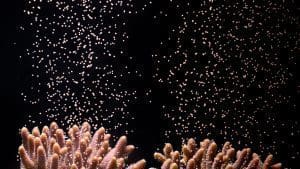
Furthermore, coral spawning contributes to the overall biodiversity of marine ecosystems. Coral reefs support a vast array of marine life, including fish, invertebrates, and other organisms. The abundance and health of these diverse ecosystems are intricately linked to the reproductive success of corals and the availability of suitable habitats for the settlement and growth of coral larvae.

